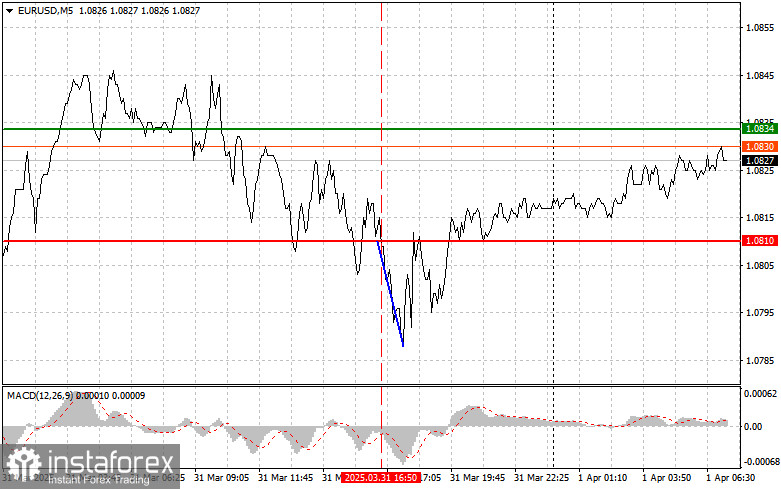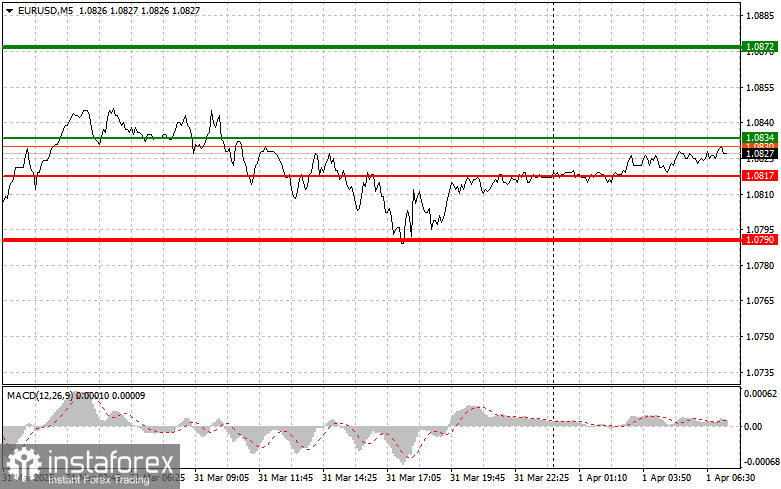Trade Review and EUR Trading Advice
The test of the 1.0810 level occurred just as the MACD indicator began to move down from the zero mark, confirming a valid entry point for selling the euro and resulting in a decline of more than 20 points.
Today, the Eurozone is set to release several key data points that could significantly influence the direction of the EUR/USD pair. It begins with manufacturing PMI figures, which still reflect serious problems in the sector, so euro buyers may not respond positively. However, the main focus will be on the Consumer Price Index and core inflation data from the Eurozone. If a slowdown in inflation is recorded for March, it will be welcomed by the European Central Bank and could support continued rate cuts. On the other hand, if the core index rises, the ECB will likely delay its next rate cut until the summer.
The market's response will also depend on how much actual figures deviate from forecasts. If inflation is much lower than expected, the euro may weaken. Conversely, higher-than-expected inflation figures will strengthen the euro by reducing the chances of aggressive rate cuts. The Eurozone unemployment rate for February is not expected to affect the euro much, as it will likely match economist forecasts. Nonetheless, these numbers will provide a more complete picture of the Eurozone economy.
For the intraday strategy, I will focus mainly on implementing Scenarios #1 and #2.

Buy Scenarios
Scenario #1: Today, buying the euro is possible when the price reaches around 1.0834 (green line on the chart) with a target of rising to 1.0872. I plan to exit the market at 1.0872 and open short positions in the opposite direction, aiming for a 30–35 point retracement from the entry point. Buying the euro in the first half of the day is only advisable after strong Eurozone data. Important: Before buying, make sure the MACD indicator is above the zero line and just starting to rise from it.
Scenario #2: I also plan to buy the euro today in the event of two consecutive tests of the 1.0817 price level, provided the MACD indicator is in the oversold area. This will limit the pair's downward potential and trigger a market reversal to the upside. A rise toward 1.0834 and 1.0872 can be expected.
Sell Scenarios
Scenario #1: I plan to sell the euro after reaching the 1.0817 level (red line on the chart), with a target of 1.0790, where I'll exit short positions and immediately open long positions in the opposite direction (targeting a 20–25 point retracement from the level). Selling pressure could return today if the data is weak. Important: Before selling, make sure the MACD indicator is below the zero line and just starting to decline from it.
Scenario #2: I also plan to sell the euro today if there are two consecutive tests of the 1.0834 level while the MACD is in the overbought zone. This would limit the pair's upward potential and lead to a downward reversal. A decline toward 1.0817 and 1.0790 can be expected.

Chart Key:
- Thin green line – the price at which the instrument can be bought
- Thick green line – projected price for placing Take Profit or manually securing profit, as further growth is unlikely beyond this level
- Thin red line – the price at which the instrument can be sold
- Thick red line – projected price for placing Take Profit or manually securing profit, as further decline is unlikely below this level
- MACD Indicator – it is crucial to consider overbought and oversold zones when entering the market
Important: Beginner traders in the Forex market should be extremely cautious when deciding to enter a trade. It's best to stay out of the market ahead of important fundamental reports to avoid sharp price swings. If you choose to trade during news releases, always place stop-loss orders to minimize losses. Without stop-losses, you can lose your entire deposit very quickly, especially if you don't use proper money management and trade with large volumes. And remember: successful trading requires a clear trading plan, like the one presented above. Making impulsive trading decisions based on current market noise is an inherently losing strategy for intraday traders.





















